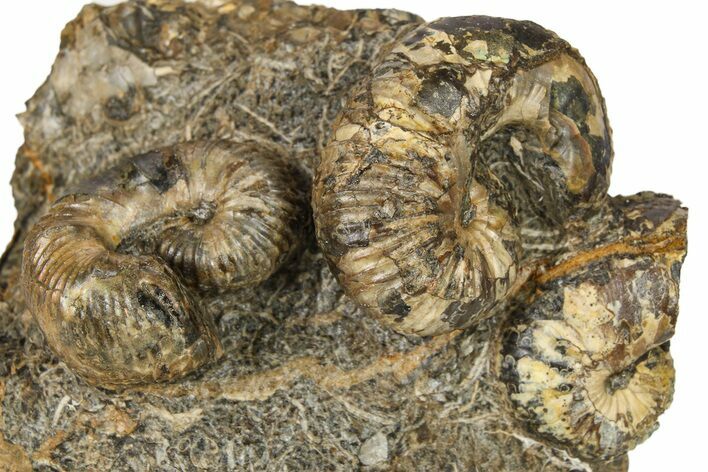Three Cretaceous Fossil Heteromorph (Scaphites) Ammonites - Utah
This is a really cool multiple heteromorph ammonite (Scaphites) specimens collected from the Dragon Valley Mine in Emery County, Utah. Unlike most ammonites that lived in a tightly-coiled spiral shell that retains the shape throughout the cephalopod's life, heteromorph ammonites have irregularly-coiled or uncoiled shells. These heteromorph ammonites are from a Late Cretaceous-aged deposit. They are similar to the species Scaphites whitfieldi but based on a conversation with ammonite expert Neal Larson, they probably represent a new, undescribed species.
The ammonites have been painstakingly exposed from the hard mudstone surrounding them. The rock also contains a variety of shell fragments. Comes with an acrylic display stand.
The ammonites have been painstakingly exposed from the hard mudstone surrounding them. The rock also contains a variety of shell fragments. Comes with an acrylic display stand.
About Ammonites
Ammonites were ancient marine cephalopods, similar to today's squids and octopuses, but with a defining feature: their distinctive, tightly coiled spiral shells. These shells, resembling those of modern nautiluses, served as both a protective home and a buoyancy aid, allowing ammonites to navigate the prehistoric seas with ease. First emerging around 240 million years ago in the Triassic Period, ammonites thrived for over 175 million years, adapting through numerous forms and sizes. As predatory creatures, they likely fed on smaller marine organisms, using their tentacles to capture prey. However, their long reign came to an end 65 million years ago at the close of the Cretaceous, coinciding with the mass extinction event that also eliminated the dinosaurs.
Ammonites were ancient marine cephalopods, similar to today's squids and octopuses, but with a defining feature: their distinctive, tightly coiled spiral shells. These shells, resembling those of modern nautiluses, served as both a protective home and a buoyancy aid, allowing ammonites to navigate the prehistoric seas with ease. First emerging around 240 million years ago in the Triassic Period, ammonites thrived for over 175 million years, adapting through numerous forms and sizes. As predatory creatures, they likely fed on smaller marine organisms, using their tentacles to capture prey. However, their long reign came to an end 65 million years ago at the close of the Cretaceous, coinciding with the mass extinction event that also eliminated the dinosaurs.
$245 $175
SPECIES
Scaphites cf. whitfieldi
AGE
LOCATION
Dragon Valley Mine, Emery County, Utah
SIZE
Largest Ammonite: 1.1" wide, Rock: 2.8 x 2.6"
CATEGORY
ITEM
#266735
We guarantee the authenticity of all of our specimens.
 Reviews
Reviews















